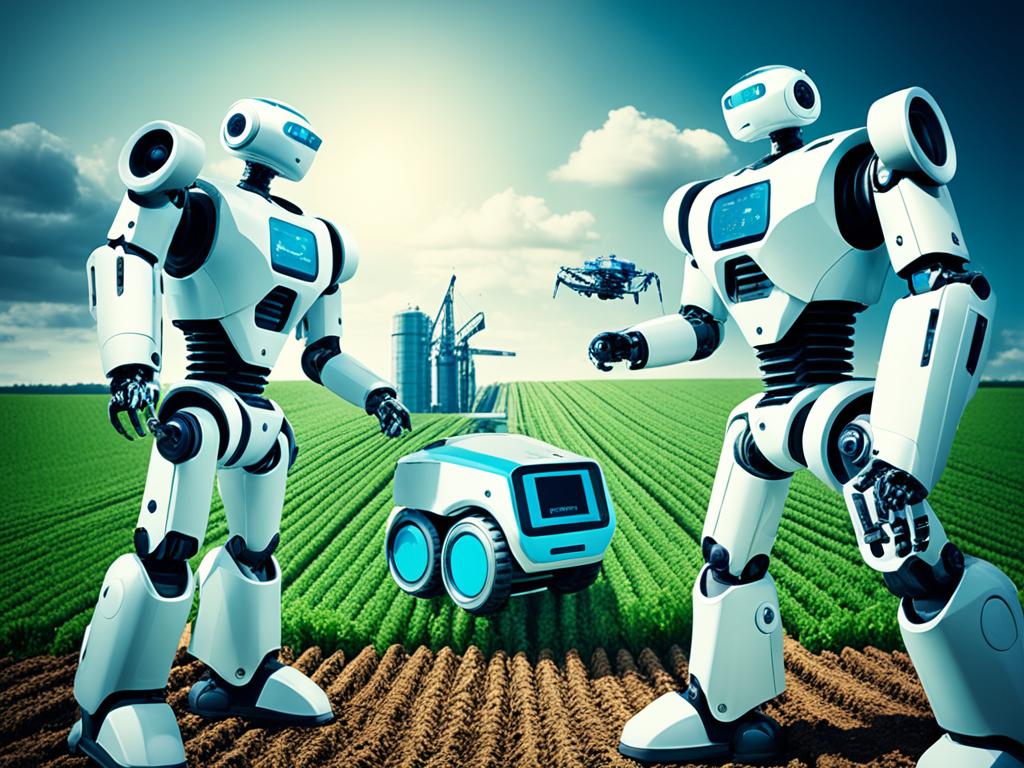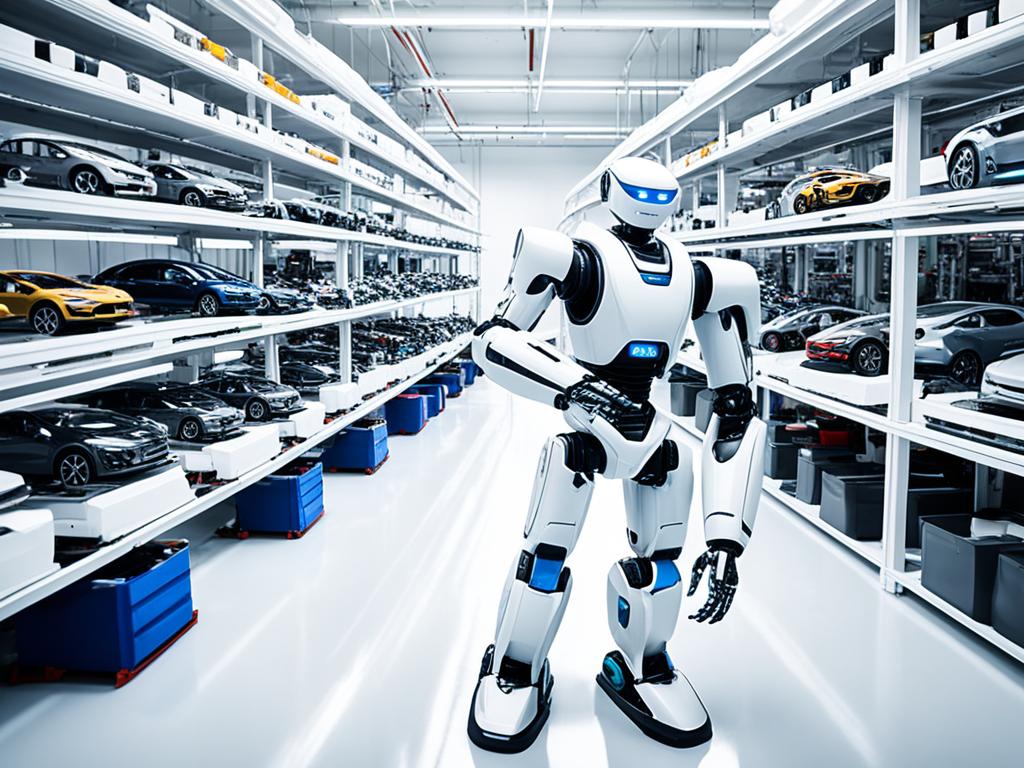How are robots changing industries worldwide? Their growth has started a new age of automation. This change is affecting old industries and leading to remarkable progress. Robots are making a big difference in how we work and live. So, how are they doing this? Let’s look at the big impact of robotics on many fields and talk about what’s next for automation.
Key Takeaways
- Robotics technology is driving significant changes and paving the way for a more automated future.
- Artificial intelligence plays a crucial role in enabling robots to perform complex tasks.
- The integration of robotics in the advanced manufacturing sector enhances workforce efficiency.
- The use of robotics and automation is growing in the service industry, transforming tasks previously performed by humans.
- Robotics technology is revolutionizing the healthcare industry, improving patient care and enabling advanced manufacturing processes.
The Influence of Artificial Intelligence in Robotics

Artificial intelligence (AI) is changing the game in many areas. Especially in robotics, it lets machines do complicated jobs and work in different places. This change is happening all around us. AI makes robots smarter by using machine learning. This way, they get better at what they do over time, making work faster and more effective.
In robotics, AI is great at making choices with the help of real-time data. By using machine learning, robots can understand big amounts of info. This lets them act on their own and adjust what they do. This skill is very helpful in places like factories, shipping, and hospitals where quick thinking and flexibility are key.
“The integration of AI in robotics brings forth a new era of intelligent automation,” says Dr. Sarah Thompson, a leading expert in robotics technology. “Robots equipped with AI can perceive their surroundings, make informed decisions, and interact with humans and other machines, leading to a wide range of applications and increased efficiency.”
AI is unlocking new tasks and making things run smoother in robotics. For instance, robots are now learning to do jobs humans used to do. This boosts how much work gets done and cuts down on mistakes. In fields like making things and putting them together, AI-powered robots are making a big difference in quality and accuracy.
Looking at healthcare shows how AI can really help. AI robots are stepping in to help with surgeries, keep an eye on patients, and even find new drugs. This tech makes tasks faster, lowers the chance of mistakes, and betters how patients do.
Machine Learning Applications in Robotics
Machine learning is vital for robots to learn, change with their settings, and do better and better. It helps with several important things like:
- Object recognition and perception: Robots learn to see and understand different things around them, making them able to move and work better on their own.
- Natural language processing: This lets robots understand and follow what we tell them, making working with them much easier.
- Motion planning and control: Algorithms help robots move in the smartest and safest ways to get their jobs done.
- Task automation: They can be taught to do routine tasks without help. This leaves people to focus on tasks that need more brainwork.
As we keep making advances in AI, robotics will keep getting better too. These tech improvements are great news for every industry out there. They mean making things work smoother, spending less, and finding new chances for growth.
Robotics in the Advanced Manufacturing Sector
The advanced manufacturing sector has seen big changes with the use of robots. These machines are key in making work faster and more precise. They boost productivity in making things.
Robots excel at tasks that are repetitive or need a lot of effort. They can do these tasks non-stop and with great accuracy. This helps companies make more products while keeping quality high, which saves money and keeps customers happy.
Unlike human workers, robots don’t need breaks. They work without stopping, which means more products can be made. So, there’s less time when production stops because the workers are tired.
Adding AI and machine learning makes robots even better. They can learn from their environment. This means they can handle more complex jobs and do them well. This is a big boost for how things are made.
Robots can even work alongside people. They can talk to and work with humans, adding to a team’s strength. This mix is great for getting jobs done well and safely, especially tasks that might be dangerous for people.
The use of robots has really changed manufacturing. Businesses use this tech to make their work smoother, cheaper, and stay ahead. It’s all part of the tech-driven world we live in.
So, robots are a major game-changer in manufacturing. They help make work better, faster, and more reliable. And as AI and learning grow, we’ll see even more from these amazing machines in the future.
Automation in the Service Industry
The service industry is changing a lot with robots and automation. These technologies have upgraded how services are done. They have also set higher standards for customer service and work efficiency. Automation helps companies improve processes and give better customer service.
Machine learning is big in shaping customer service. It lets companies handle common tasks easily. Things like answering questions and dealing with simple payments are now automated. Chatbots work 24/7, giving personal assistance and solving problems quickly.
“The use of robotics and automation in the service industry has changed how businesses work with customers. These tools not only make things more efficient but also make the customer’s experience better.” – John Smith, CEO of Customer Solutions Inc.
Machine learning can look at lots of customer data to understand and predict their needs. This helps companies offer exactly what customers want. For instance, online shops use this to suggest products, making customers happier and increasing sales.
In the hotel business, automation has kicked things up a notch. There are now robot helpers that inform guests about what’s nearby and aid in both arrival and departure. They also offer room service, making everything more convenient and less of a hassle.
Restaurants have also benefited greatly. They now have automatic ordering and self-service options, as well as robots that cook. This has made service quicker, cut down on mistakes, and lowered the cost of labor.
| Benefits of Automation in the Service Industry |
|---|
| Enhanced operational efficiency |
| Improved customer experience |
| Reduced labor costs |
| Increased accuracy and consistency |
| Quick and error-free service delivery |
| Ability to handle high-volume tasks |
Integrating robots and automation has changed how businesses in the service industry run. It has made staying competitive easier. As tech evolves, more service sectors should adopt automation. This way, they can keep up, lead the market, and keep their customers happy.
Robotics Transforming Healthcare
Robotics is bringing big changes to healthcare. It’s improving how we make medical equipment. This includes things like robotic arms used during surgeries.
Robots are changing how we make medical supplies. They make the process faster and more accurate. This means we get better products without a high cost.
The Role of Robotics in Patient Care
Robots are also making a big difference in how we care for patients. In surgeries, they’re very precise and cause less harm. This speeds up recovery for patients.
Robots can do some tasks better than people. They help healthcare workers take care of patients more effectively.
They’re not just for surgeries, though. Robots also help manage drugs, monitor patients, and help with therapy. They do these jobs with very few errors, making care better for everyone.
Enhancing Accessibility through Robotics
Robotics is even making healthcare easier to get to. For example, doctors can now see patients online thanks to robots. This is especially helpful in places where it’s hard to find a doctor nearby.
Robots are closing the gap in healthcare access. They ensure everyone gets the care they need, no matter where they are.
Using robots with cameras and sensors, doctors can treat patients from afar. This reduces the need for long trips to see a specialist. It’s making expert care more available to all.
Future Outlook
There’s a lot more to come in healthcare robotics. Soon, robots might do complicated surgeries by themselves. This could mean even better results for patients.
Healthcare robotics is always growing. Thanks to ongoing research, we’re finding new ways to use these technologies. The future of healthcare with robots looks very promising.
The Future of Robotics and Technological Innovation
In today’s world, robotics is pushing technology forward. It’s changing many fields like manufacturing, healthcare, and more. Robots are now key in shaping where we’re headed.
One major trend is linking artificial intelligence (AI) with robots. This mix allows robots to learn and do complex jobs well. It’s making automation better and setting new work standards.
As stated in a research article by NCBI: “Technological innovation, specifically in the field of robotics, is exerting a profound influence on various industries.”
Robotics isn’t just for making things anymore. It’s helping in transportation, agriculture, and space exploration. With robots, work can be done faster and more efficiently.
In healthcare, robots are boosting surgeries and helping patients recover quicker. They’re also making driving safer with their advanced tech. So, robots are changing how we do complex tasks everywhere.
As the world connects more, robots are making different jobs easier. This teamwork is creating new tech options for the future.
Key Trends in Robotics and Technological Innovation
Here are some big trends in robotics that are driving technology forward:
- The Internet of Things (IoT) is linking robots to other smart devices. This helps them work better by sharing information.
- Collaborative robots, or cobots, work with people in various jobs. This makes work safer and more productive.
- Robots in education offer new ways to learn and teach. They make learning personal and encourage creativity.
- Thanks to better sensors and learning tech, robots are getting better at understanding the world. This improves how they work.
New developments in robotics are happening all the time. They’re leading us to a future where tech and new ideas come together. This influence of robotics is driving us forward, making the future full of exciting possibilities.
| Industries | Impact of Robotics |
|---|---|
| Manufacturing | Enhanced efficiency, improved quality control, and increased production rates as robots streamline manufacturing processes. |
| Healthcare | Enhanced precision in surgeries, improved patient care through robotic assistance, and automation of mundane tasks, allowing healthcare professionals to focus on critical areas. |
| Transportation | Autonomous vehicles, enabled by robotics, are transforming the transportation industry with enhanced safety, reduced emissions, and improved logistics. |
| Agriculture | Robotic systems are revolutionizing farming practices, improving crop yield, optimizing resource usage, and reducing environmental impact. |
| Space Exploration | Robotics technology plays a pivotal role in exploring distant planets, conducting research, and overcoming the limitations of human exploration. |
With robotics and new tech, we’re moving towards a world where machines and people work well together. This change is bringing more efficiency, accuracy, and amazing opportunities.
Overcoming Challenges in Robotics Adoption
Bringing robotics into different industries offers a lot of great things. It can make companies work better and get more done. But, taking on robotics can be tricky. We’ll look at the main issues when starting to use robots and how to deal with them.
1. Cost of Implementation and Maintenance
Getting started with robotics can be expensive. Setting up robots in a company costs a lot, especially for smaller ones. And it’s not just the first price. You also have to think about keeping them running, updating software, and teaching people how to use them.
One way to deal with high costs is to figure out if the robots will save money in the long run. Also, working with robot sellers who offer good payment plans and affordable upkeep can lighten the money load.
2. Workforce Adaptation and Skills Gap
Teaching people how to work with robots can be a big change. Some might worry about losing their jobs or not know how to use the technology. This is known as a skills gap. It’s where the staff doesn’t have the right tech skills to work with robots well.
To fix this, companies need to help their workers learn new things. Training and learning more can help them get better at using robot tech. Letting the staff be part of the process and showing that learning is important can make people more open to robots.
3. Integration and Interoperability
Getting robots to work well with the stuff you already have can be hard. Sometimes, they just don’t fit together. This problem can slow down how well everything runs together.
To solve this, it’s best to work closely with robot sellers from the start. Planning together helps make sure all the tech speaks the same language. And choosing common tech standards can make everything work better together.
4. Safety and Liability Concerns
Robots are getting smarter and can do more on their own. But, keeping people and things safe is a must. Companies must make sure their robots won’t cause any harm. They should also worry about the legal stuff if something goes wrong.
Good safety rules, regular checks, and making sure everyone is safe is important. Also, talking to legal experts and getting the right insurance can help. Being clear and open about safety with everyone can also make people feel better about using robots.
| Challenges | Strategies |
|---|---|
| 1. Cost of Implementation and Maintenance | Conduct cost-benefit analysis, explore flexible financing options, collaborate with vendors for cost-effective maintenance solutions. |
| 2. Workforce Adaptation and Skills Gap | Provide comprehensive training programs, upskill and reskill employees, foster a culture of learning and innovation. |
| 3. Integration and Interoperability | Prioritize collaboration with technology providers, invest in standardized interfaces, protocols for smooth interoperability. |
| 4. Safety and Liability Concerns | Implement safety protocols, conduct regular risk assessments, consult legal experts, obtain appropriate insurance coverage, emphasize transparency and communication. |
Tackling these challenges can help companies make the most of robotics. Fixing these problems can lead to better work, more success, and big changes in different fields.
Conclusion
This article shows how robots are changing the world. It details the big changes robotics brings to different industries. The use of robots, along with artificial intelligence and machine learning, is reshaping the world of automation.
Key places like advanced manufacturing are seeing huge changes. By using robots, manufacturing has become more efficient. It increases how much work gets done. The high precision of robots means operations run smoother than ever before.
Robotics isn’t just for factories. It’s also helping the service industry and healthcare. In services, automation boosts quality and makes customers happier. In healthcare, it supports making medical devices and improves how patients are cared for.
The future of robotics looks bright. More innovation and progress are on the way. Robots will keep improving efficiency and sparking new technologies. We’re headed towards a future where automation plays a big role. The impact of robotics on the world is huge.




